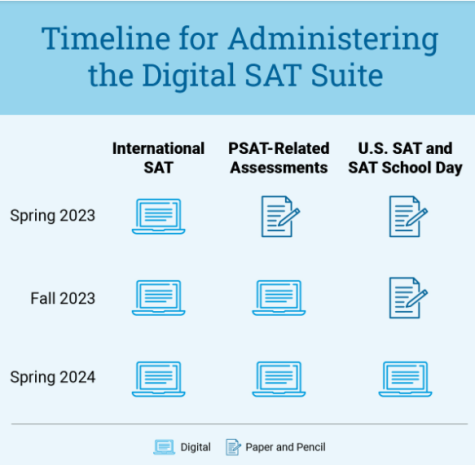Changes to the SAT
Image by Jason T. Poplin
Seaman Chanthorn Peou from San Diego, California, takes his Scholastic Aptitude Test (SAT) aboard the aircraft carrier USS Kitty Hawk, even sailors need to do their SAT!
The SAT, or Scholastic Aptitude Test, is a test given by the state to measure students’ abilities in the fields of reading, writing, and math. It serves as a way to provide an unbiased measurement of an applicant’s skills for a college reviewer to decide if the person should be accepted into the college.
With the past few years of the COVID-19 pandemic, the SAT had to adapt to the new digital needs of administrators and teachers, switching to a digital version of the SAT during digital learning. However, this change to online will be permanent, as College Board recently announced.
“While the transition to digital will bring a number of students- and educator-friendly changes, many important features of the SAT Suite (SAT, PSAT/NMSQT®, PSAT™ 10, PSAT™ 8/9) will stay the same,” explains College Board in their recent announcement.
The digital SAT itself will feature two sections, a Reading and Writing section and a Math section, with a break in between each section. These sections are divided into two modules, where students will have to finish the first module to reach the next. The questions in the second module will depend on the performance of the student in the first module.
The advantages of this switch to a digital SAT are that scores will be received in mere days, rather than the usual weeks it takes. This change also means that the digital SAT is more secure, as everyone receives a unique test form. This allows for the sharing of answers and the cancellation of scores for a group of students due to a single compromised test to be impossible.
College Board has also announced that the digital SAT will be shorter, being only 2 hours long instead of the usual 3 hours. To compensate for this change, there will be more time allotted per question and shorter reading passages that have a wider range of topics that reflect works that students will read in college.
“With the transition to digital tests, College Board is working to address inequities in access to technology,” states College Board in the same announcement.
The digital SAT will be administered in a testing center or at school. Students will be able to use a school-issued device or their own devices on testing day, if a student doesn’t have either, College Board will provide them with one on testing day. Students will not lose time or progress if a device loses power or connection while they are taking the SAT.

The digital SAT will be offered at international test centers in March of 2023. However, the United States will still be taking a paper and pencil test up until the spring of 2024. Registrations for the first international digital SAT session will start in the fall of 2022.
Your donation will support the student journalists of Mt. SAC Early College Academy. Your contribution will allow us to purchase equipment and cover our annual website hosting costs.

Brandon Beetz-Gonzalez is a Sophomore at Mt. SAC ECA and this is his first year of being a part of the Chronicle staff. Brandon is actively involved in...







